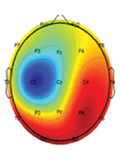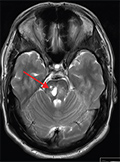The eLitMed.hu medical portal uses computer cookies for convenient operation. Detailed information can be found in the Cookie-policy.
Clinical Neuroscience - 2016;69(01-02)
Content
Facial virus inoculations infect vestibular and auditory neurons in rats
Background and purpose – There is growing evidence for the viral origin of the Bell’s facial palsy, vestibular neuritis and sudden sensorineural hearing loss, however their exact pathophysiology is still unknown. We investigated the possibility of brainstem infections following peripheral viral inoculations in rats. Methods – Pseudorabies virus, a commonly used neurotropic viral retrograde tracer was injected into the nasolabial region of rats. Five and 6 days after injections, infected brainstem nuclei were demonstrated by immunohistochemical techniques. Results – Infected neurons were found in the motor facial, the medial vestibular, and the sensory trigeminal nuclei, as well as in the medial nucleus of the trapezoid body. Conclusion – Pseudorabies virus infects auditory and vestibular sensory neurons in the brainstem through facial inoculation. The possible routes of infections: 1. trans-synaptic spread constituted by facio-vestibular anastomoses: primarily infected motor facial neuron infects neurons in the medial vestibular nucleus, 2. via trigeminal sensory nerves: the sensory trigeminal complex innervated by GABAergic medial vestibular neurons, and 3. one bisynaptical route: infected facial motoneurons may receive indirect input from the medial vestibular nucleus and the trapezoid body via connecting neurons in the sensory trigeminal complex. We may assume that latent infections of these areas may precede the infections of the peripheral organs and the reactivation of the virus exerts the symptoms.
[A visual based proto-consciousness model of human thinking]
[Background and objectives – Here we present our results of many years of research on the visual (pictorial) representation model expanded with some new ideas in a simplified form. Our goal is to make available our new pictorial model for a broader scientific community and to point to its possible importance in the future. Method – Own scientific publications, selective literature analysis and preliminary experiments. Results – Our several scientific publications and preliminary experiments were presented outlining our new molecular visual representation model as brain might be able to generate internal images by regulated biophotons in early V1 retinotopic visual regions. We also proposed that some of symptoms and characteristics of autism and savantism may suggest that visual (pictorial) thinking might be a possible cognitive model in the case of healthy people as well. Our model can present a uniform molecular basis for many visual related phenomena. Conclusions – It is possible that a so-called visual proto-consciousness might be developed in evolution, which is directly related to the retinotopic visual areas, and which has a different cognitive ability from verbal abilities. If our model can be exactly proved it presents a common molecular basis for various visual phenomena such as visual perception and imagination, phosphenes ect. and might open new ways in several fields of science such as visual prosthesis for the blind, artificial intelligence, visual neuroscience, cognitive and autism research.]
Unanswered questions in the transcranial magnetic stimulation treatment of patients with depression
According to the WHO fact sheet depression is a common mental disorder affecting 350 million people of all ages worldwide. Transcranial Magnetic Stimulation (TMS) is a technique which allows the investigator to stimulate and study cortical functions in healthy subjects and patients suffering from various mental and neurological disorders. In the early 1990s, studies revealed that it is possible to evoke long term mood changes in healthy volunteers by rapid rate repetitive, TMS (rTMS) over the frontal cortex. Subsequent studies involving depressed patients found frontal cortical rTMS administered daily to be clinically effective. In the past two decades, numerous trials examined the therapeutic potential of rTMS application in the treatment of mood disorders with constantly evolving treatment protocols. The aim of this paper is to review the literature of the past two decades, focusing on trials addressing the efficacy and safety of rTMS in depressed patients. Our primary goal is to evaluate the results in order to direct future studies which may help investigators in the development of treatment protocols suitable in hospital settings. The time is not far when TMS devices will be used routinely by practitioners primarily for therapeutic purpose rather than clinical research. To our knowledge, a widely accepted “gold standard" that would offer the highest efficacy, with the best tolerability has not been established yet. In order to approach this goal, the most important factors to be addressed by further studies are: localization, frequency, intensity, concurrent medication, maintenance treatments, number of pulses, trains, unilateral, or bilateral mode of application.
[Event-related potentials and clinical symptoms in schizophrenia]
[The investigation of schizophrenia’s aetiology and pathomechanism is of high importance in neurosciences. In the recent decades, analyzing event-related potentials have proven to be useful to reveal the neuropsychological dysfunctions in schizophrenia. Even the very early stages of auditory stimulus processing are impaired in this disorder; this might contribute to the experience of auditory hallucinations. The present review summarizes the recent literature on the relationship between auditory hallucinations and event-related potentials. Due to the dysfunction of early auditory sensory processing, patients with schizophrenia are not able to locate the source of stimuli and to allocate their attention appropriately. These deficits might lead to auditory hallucinations and problems with daily functioning. Studies involving high risk groups may provide tools for screening and early interventions; thus improving the prognosis of schizophrenia. ]
Long term follow-up of lesional and non-lesional patients with electrical status epilepticus in slow wave sleep
Objectives – A retrospective study has been done at the Bethesda Children’s Hospital Epilepsy Center with those patients whose EEG records fulfilled in one or more records the criteria of electrical status epilepticus in slow wave sleep (ESES) pattern, occupying at least 75% of NREM sleep with bilateral discharges, and had detailed disease history and long term follow-up data, between 2000 and 2012. Patients and methods – Thirty-three patients (mean 11.1±4.2 years of age) were studied by 171 sleep EEG records. Sleep was recorded after sleep deprivation or during spontaneous sleep at least for one hour length of NREM. From the 492 EEGs, 171 sleep records were performed (average five/patient). Average follow-up time was 7.5 years. Eighty-two ESES records have been analyzed in 15 non-lesional and 18 lesional (11 with dysgenetic and seven with perinatal - asphyxic or vascular origin) patients. Variability of seizure types, seizure frequency and frequency of status epilepticus was higher in the lesional group. Impairment of the cognitive functions was moderate and partial in the non-lesional, while severely damaged in the lesional group. Results – EEG records of 29 patients showed unihemispherial spike fields with a perpendicular axis (in anterior, medial and posterior variants) to the Sylvian fissure, regardless their lesional or non-lesional origin. Only three (1one non-lesional and two lesional) patients had bilateral synchronous spike-wave discharges with bilateral symmetric frontocentral spike fields. The individual discharges of the sleep EEG pattern were very similar to the awake interictal records except their extension in time and field, their increased number, amplitude, and continuity of them and furthermore in the increased trans-hemispheral propagation and their synchronity. Conclusions – Assumed circuits involved in the pathomechanism of discharges during NREM sleep in ESES are discussed based on our findings.
Internet and stroke awareness in the young hungarian population
Background – Although stroke mortality rate in Hungary has tapered off over the last years, it is still twice the European average. This statistic is alarming and a coordinated response is needed to deal with this situation when considering new ways of communication. There are currently more than 300 websites in Hungarian related to stroke prevention, acute stroke treatment, recovery and rehabilitation. Aims and/or hypothesis – We sought to identify base level of stroke knowledge of the Hungarian students and the efficiency with which the knowledge disseminated by internet is actually utilized. Methods – We surveyed 321 high-school and university students to determine their ability to extract specific information regarding stroke from Hungarian websites. The base level of knowledge was established by asking 15 structured, close-ended questions. After completing the questionnaire, students were asked to search individually on stroke in the internet where all the correct answers were available. After a 25-min search session they answered the same questionnaire. We recorded and analyzed all their internet activity during the search period. Results – The students displayed a fair knowledge on the basics of stroke but their results did not change significantly after the 25-min search (53±13% vs. 63±14%). Only correct information given on demographic facts improved significantly. Most of the students used very simple search strategies and engines and only the first 5-10 web-pages were visited. Conclusion – Analysis of the most often visited web-pages revealed that although stroke-related Hungarian web-based resources contain almost all the important and required information the unsuitable structure, lack of simplicity and verbosity hinder their effective public utilization.
[Financing of medicines for treatment of rare diseases of the nervous system. orphan drugs in rare neurological diseases]
[Objectives – Nervous system involvement is expected up to 60-70% in case of rare diseases. This article aims to present the financial methods and expenditures of rare neurological diseases’ orphan medicinal products being financed in the frame of Hungarian social insurance system in 2012. Methods – The subsidized orphan medicines were selected on the Orphanet portal 2012 while orphans financed by compessionate use were provided by the Hungarian National Insurance Fund Administration (OEP) database. Three products exist without orphan designation, however those are intended for the treatment of rare neurological ailments. The medicines were categorized by financial methods and determined by costs. Results – Numerically, out of 36 pieces of subsidized orphan or orphan criteria fulfilled medicines 17 were authorized for the treatments of rare neurological diseases in the year of 2012. Most of the drugs (14 pieces) were to be financed in the frame of compassionate use by the reimbursement system. The cost amount of social insurance for 387 rare neurological disease patients reached more than 4.5 billion HUF (1.4% of the total pharmaceutical budget in outpatient care). Conclusions – In Hungary half of the subsidized orphans are intended for the treatments of rare neurological ailments. 30% of the total amount of social insurance for rare diseases’ medicinal treatments were used to subsidizing rare neurological disease patients in 2012. Most of the orphan medicines were to be financed in the frame of compassionate use by the reimbursement system for outpatient care. Consequently, a great deal of crucial problems occurred in relation with the unconventional subsidizing method. At the end of 2012 new financial methods have been elaborated and introduced in a pilot phase from 1 January 2013. In spite of the high cost commitment, nearly the entire diagnosed rare disease subpopulation have been provided with subsidized treatments in Hungary. In order to facilitate the acces to orphan medicines, collaboration shall be achieved by financing authority and professionals for identificating the descently sustainable, affordable and viable financial method. ]
Comparison of hospitalized acute stroke patients’ characteristics using two large central-eastern european databases
Objectives – Stroke is the third leading cause of death in the European region. In spite of a decreasing trend, stroke related mortality remains higher in Hungary and Romania when compared to the EU average. This might be due to higher incidence, increased severity or even less effective care. Methods – In this study we used two large, hospital based databases from Targu Mures (Romania) and Debrecen (Hungary) to compare not only the demographic characteristics of stroke patients from these countries but also the risk factors, as well as stroke severity and short term outcome. Results – The gender related distribution of patients was similar to those found in the European Survey, whereas the mean age of patients at stroke onset was similar in the two countries but lower by four years. Although the length of hospital stay was significantly different in the two countries it was still much shorter (about half) than in most reports from western European countries. The overall fatality rate in both databases, regardless of gender was comparable to averages from Europe and other countries. In both countries we found a high number of risk factors, frequently overlapping. The prevalence of risk factors (hypertension, smoking, hyperlipidaemia) was higher than those reported in other countries, which can explain the high ratio of recurring stroke. Discussion – In summary, the comparatively analyzed data from the two large databases showed several similarities, especially regarding the high number of modifiable risk factors, and as such further effort is needed regarding primary prevention.
[The propagation and semiology of focal epileptic seizures. case presentations to the insula. theoretical considerations]
[Study objectives – The developing of diagnostical examinations in epileptology provides new challenges in seizure semiology. On the analysis of seizures it is important to examine the mechanisms of their propagation. The brain connectivity (based on the neuroimaging), the shadowing of the movement of excessive neuronal activity (based on computerized EEG and MEG methods), the cognition of the physiological and pathological brain networks are the foot- stone of the epileptic seizure propagation. The investigators prove, by means of case demonstrations of the role of the network nodes and the role of the epileptic hubs in the seizure symptomatology. Methods – The preoperative, intra and postoperative data are analised of three insular and one parietal epileptic patients in point of view of their seizure symptomes. Complex neuroimaging, noninvasive and invasive electrophysiology, intensive long-term video-EEG monitoring, computerized EEG analysis, fuctional mapping, intraoperative corticography were used. The etiology were confirmed with hystology. Results – It is observed that on seizure semiology our patients plays the insula a double role. In some cases, it is the focus of insular seizures with their symptoms difficult to identify. However, in the majority of cases and as a consequence of its rich neural connections, the insula has a peculiar property in the evolution of the symptomatogenic features of seizures. This observations are developing new relationships between the mechanism of seizure propagation and its semiological consequences. Conclusions – On epileptological point of view there are brain structures which has peculiar role in the „designe” of propagation of the epileptic excitement. The numerous new methods in neuroimaging and neurophysiology allowed the connectomical examination of the epileptic networks. The role of the epileptic diathesis is approachable with the metholdology of the brain connectivity. Theoretically the node of the epileptic network consist of the potential pathes where the localised excessive excitement can propagete. The route where the actual seizure can go adhead is determined by the actual edpileptic propensity of the above mentioned potential pathes.]
To treat or not to treat, cheyne-stokes respiration in a young adult with vascular encephalopathy
Cheyne-Stokes respiration (CSR) is a form of sleep-disordered breathing characterised by recurrent central sleep apnoea alternating with a crescendo-decrescendo pattern of tidal volume, relatively rare observation in sleep labs. It is mainly seen in severe heart failure and stroke. We report the case of a young man with CSR after sudden onset of seizure in the context of hypertensive exacerbation leading to the diagnosis of a leukoencephalopathy, and comment on differential diagnoses, prognostic and therapeutic outcomes. The very uniqueness of this case consists in the extremely young age for developing a vascular encephalopathy in the absence of genetic diseases and without previous diagnose of hypertension. There is no adequate explanation for the origin of vascular encephalopathy; also there is lack of evidence regarding the benefits and modality of treatment for CSR in neurologic diseases. Thus, we were forced to find the best compromise in a nocturnal oxygen therapy and follow-up.
1.
Clinical Neuroscience
[Headache registry in Szeged: Experiences regarding to migraine patients]2.
Clinical Neuroscience
[The new target population of stroke awareness campaign: Kindergarten students ]3.
Clinical Neuroscience
Is there any difference in mortality rates of atrial fibrillation detected before or after ischemic stroke?4.
Clinical Neuroscience
Factors influencing the level of stigma in Parkinson’s disease in western Turkey5.
Clinical Neuroscience
[The effects of demographic and clinical factors on the severity of poststroke aphasia]1.
2.
Clinical Oncology
[Pancreatic cancer: ESMO Clinical Practice Guideline for diagnosis, treatment and follow-up]3.
Clinical Oncology
[Pharmacovigilance landscape – Lessons from the past and opportunities for future]4.
5.













